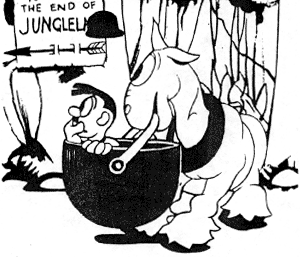The beloved cartoonist Ronald "Carl" Giles was bast known for his work in newspapers, which began in 1937. Before this coming to this medium, however, he worked in the animation industry.
The British Cartoon Archive has some biographical details about Giles' life during this period. He first entered the world of animation at the age of thirteen in 1930, when he found work washing brushes and making tea at the London advertising agency Superads. Later on, he worked as an inbetweener on Superads' animated cinema adverts. It was at Superads that Ronald Giles first earned the nickname that would later become "Carl": his co-workers felt that his haircut made him look like Boris Karloff's character in the contemporary film Frankenstein, and so dubbed him Karlo.
Steve of the River
In 1935 Giles was hired by Alexander Korda to animate on The Fox Hunt, released in 1936. His next work in the medium was made in collaboration with the Ipswich cartoonist Roland Davies, who had been drawing the comic strip Come On Steve! for the Sunday Express since 1932. With Giles as animator and Davies as producer and director, the two men put together a series adapting the strip about the adventures of Steve the Horse and his rider.
Most sources list the series as lasting for six films - Steve Steps Out, Steve's Treasure Hunt, Steve's Cannon Crackers, Steve of the River, Steve in Bohemia (viewable here) and Cinderella Steve - from 1936 to 1937. According to this fan page another short was planned but cancelled; it was set to be the character's colour debut.
There was at least one other Steve cartoon, however. The East Anglian Film Archive contains a film - viewable here - entitled simply Come On Steve! At two and a half minutes it is significantly shorter than the rest and may have been a pilot that was never commercially released, which would explain its lack of coverage.
Denis Gifford's British Animated Films lists some favourable contemporary reviews of the Steve series, but later critics were not so kind. In his book Cartoons Giannalberto Bendazzi points to the cartoons as symptomatic of everything wrong with British animation of the thirties:
The result was a failure in every respect: Davies' graphic style was insignificant, his choice of black-and-white was obsolete and even the inventions and plots were linked to an old-fashioned concept of animated film. The public did not show any interest. While lacking native artists (McLaren's unique talent was still in the making), Great Britain became a stopover for foreign animators, including Lotte Reiniger, Hector Hoppin, Anthony Gross, John Halas and Len Lye.
Fans of Giles' cartoons may be disappointed as his visual flare is hard to detect in the Steve cartoons, where he is instead imitating the style of Davies' strip. Still, he did a reasonable job within the confines of Davies' admittedly rather clunky storytelling.

One Pair of Nostrils
In 1944 Giles made his directorial debut with three propaganda and information films. The first two were made in collaboration with producer Lister Laurence; Denis Gifford lists the production company as Giles and Laurence. This first was The Grenade (viewable here, at 4:45 into the reel) which tells the story of a small explosive who is treated with contempt by larger weaponry but, upon teaming up with a soldier, defeats Hitler; the second was One Pair of Nostrils (viewable here) a "coughs and sneezes spread diseases" film set to what sounds like a Stanley Holloway monologue. Giles' third short was A Cautionary Tale, made for producer Paul Rotha and featuring a monologue which was definitely provided by Stanley Holloway; the story dealt with a factory worker cutting his finger on scrap metal and dying of sepsis as a result.
Giles' animation has its crudities, lacking timing and consistency, but the charm of his illustrative work has become clear at this point. His well-observed character design is particularly apparent - my favourite moment in his animation is a brief shot of three wonderfully snooty missiles in The Grenade.
On August 5 1945 Giles introduced his most famous creation, a family of characters that would appear in the Daily Express for decades to come. As far as I know, he never animated again.


No comments:
Post a Comment